Human Resource Management: Concepts, Models, and Strategies
VerifiedAdded on 2023/06/12
|13
|3974
|274
AI Summary
This report discusses the concepts and models of HRM and personnel management, impact of national and corporate culture on staff management, organizational levers for sustainable competitive advantage, and job design strategies. It also provides recommendations for HR practices.
Contribute Materials
Your contribution can guide someone’s learning journey. Share your
documents today.
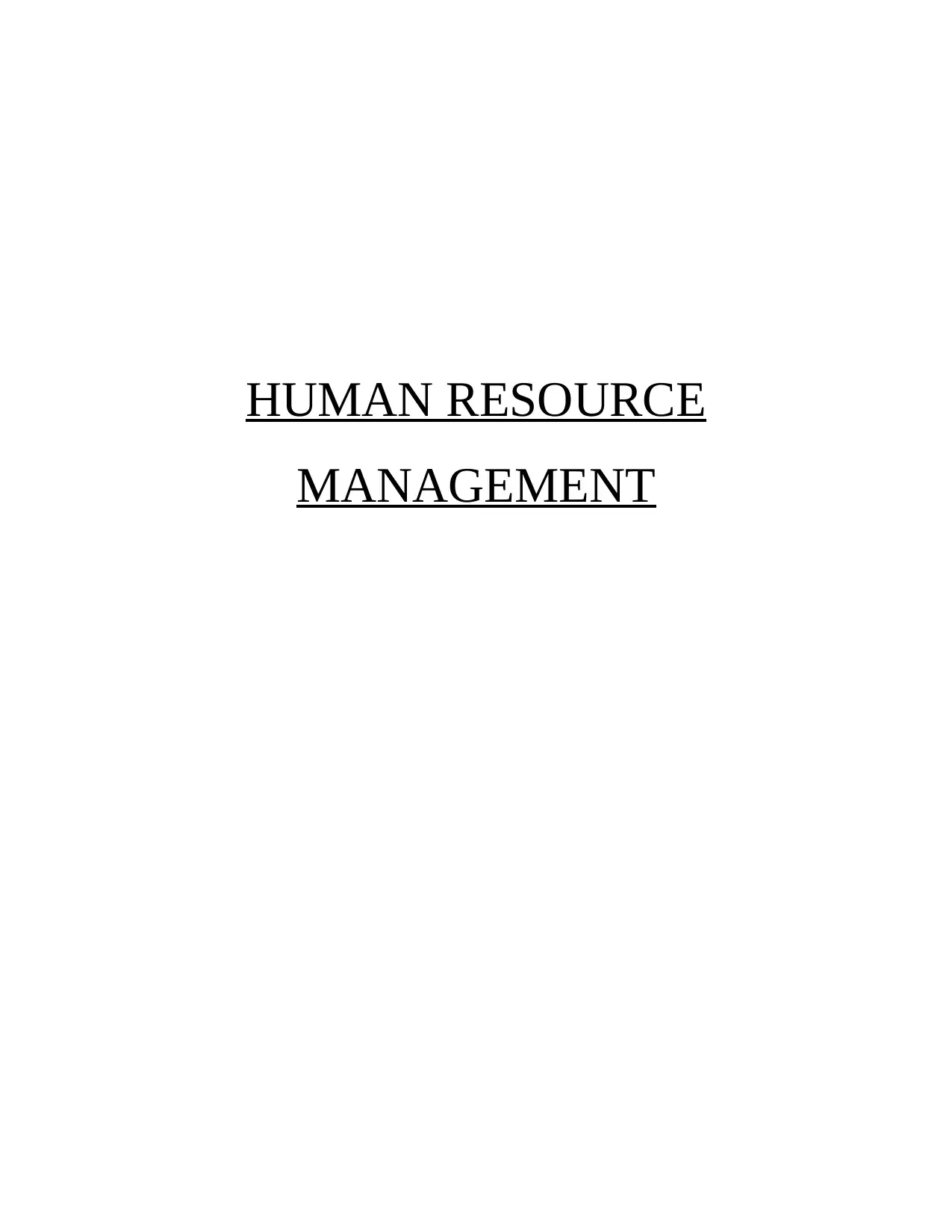
HUMAN RESOURCE
MANAGEMENT
MANAGEMENT
Secure Best Marks with AI Grader
Need help grading? Try our AI Grader for instant feedback on your assignments.
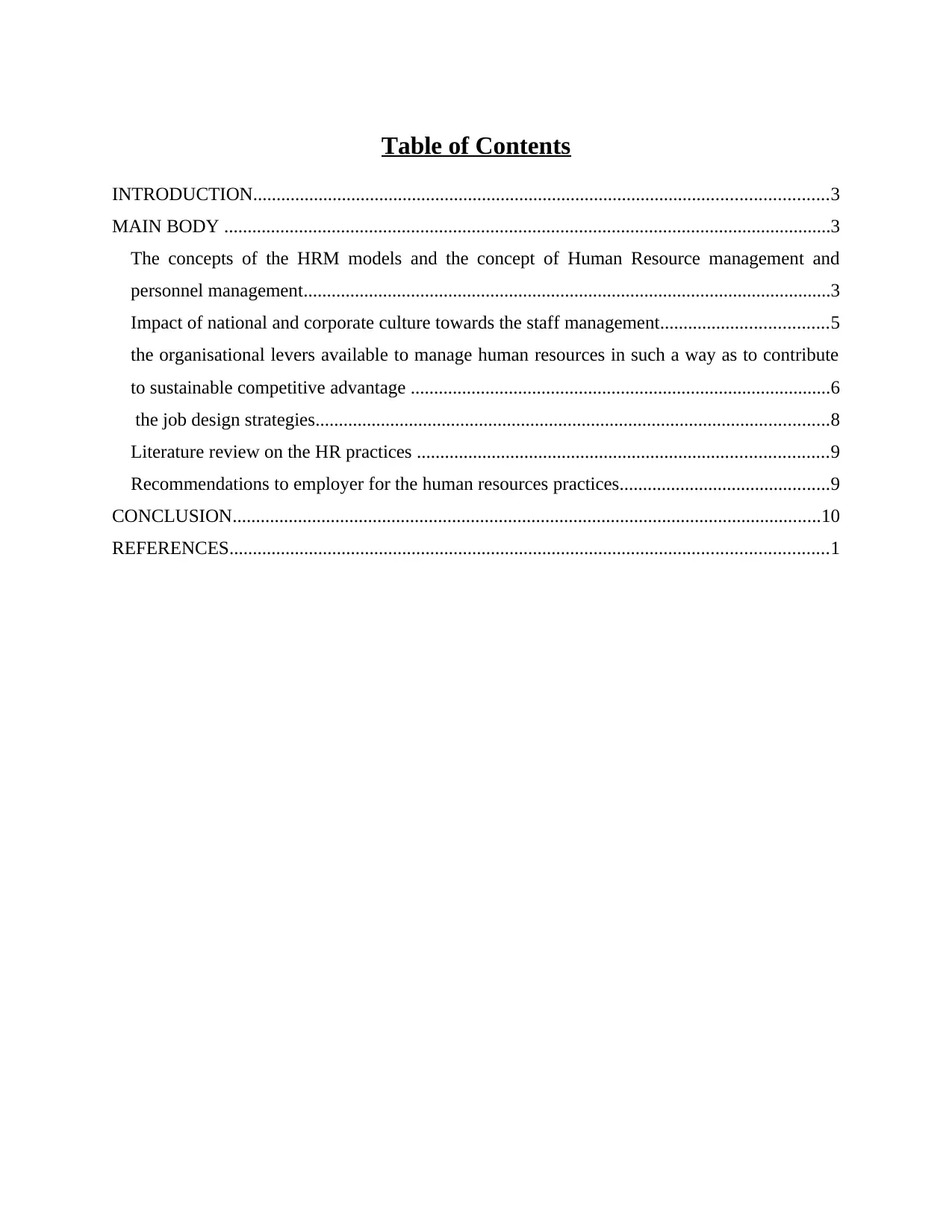
Table of Contents
INTRODUCTION...........................................................................................................................3
MAIN BODY ..................................................................................................................................3
The concepts of the HRM models and the concept of Human Resource management and
personnel management.................................................................................................................3
Impact of national and corporate culture towards the staff management....................................5
the organisational levers available to manage human resources in such a way as to contribute
to sustainable competitive advantage ..........................................................................................6
the job design strategies..............................................................................................................8
Literature review on the HR practices ........................................................................................9
Recommendations to employer for the human resources practices.............................................9
CONCLUSION..............................................................................................................................10
REFERENCES................................................................................................................................1
INTRODUCTION...........................................................................................................................3
MAIN BODY ..................................................................................................................................3
The concepts of the HRM models and the concept of Human Resource management and
personnel management.................................................................................................................3
Impact of national and corporate culture towards the staff management....................................5
the organisational levers available to manage human resources in such a way as to contribute
to sustainable competitive advantage ..........................................................................................6
the job design strategies..............................................................................................................8
Literature review on the HR practices ........................................................................................9
Recommendations to employer for the human resources practices.............................................9
CONCLUSION..............................................................................................................................10
REFERENCES................................................................................................................................1
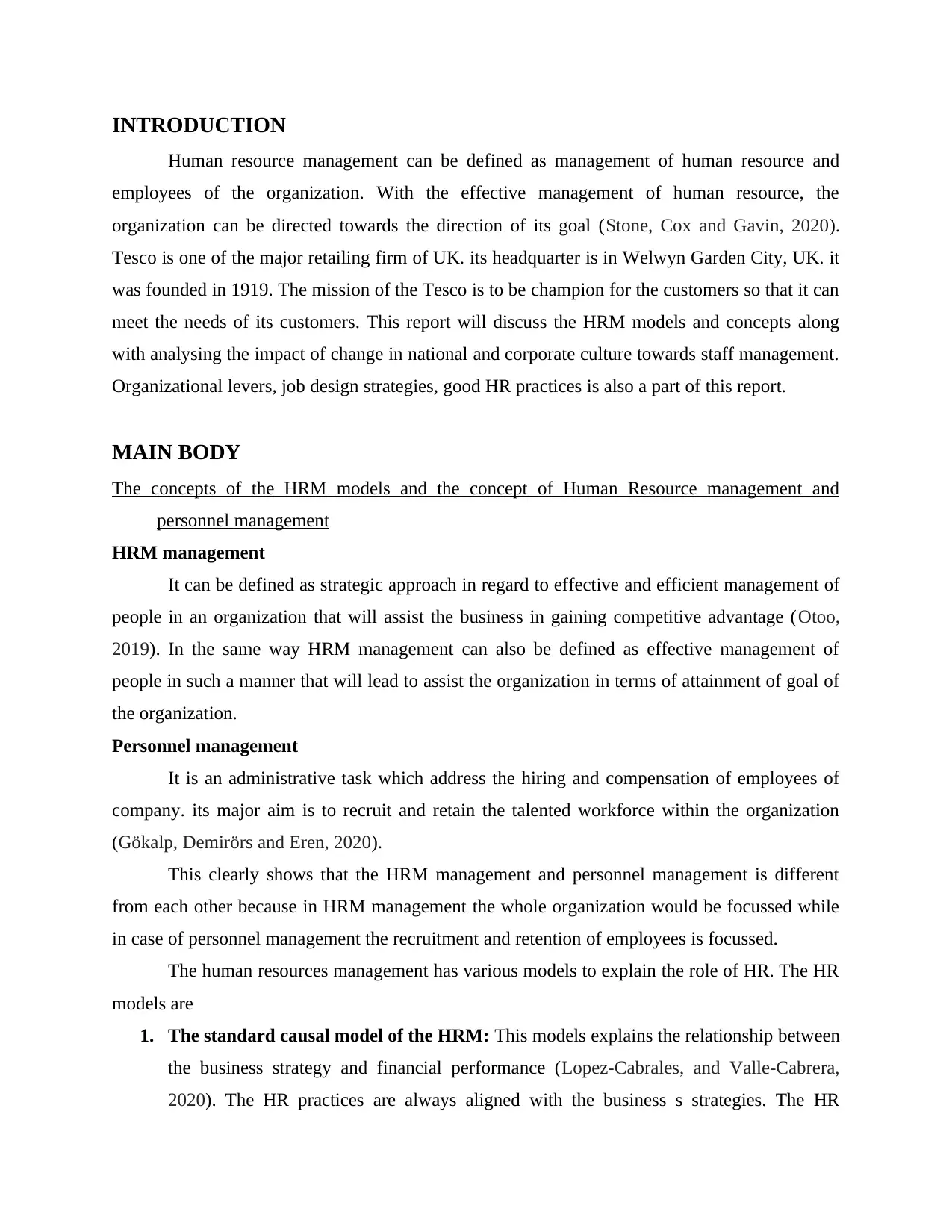
INTRODUCTION
Human resource management can be defined as management of human resource and
employees of the organization. With the effective management of human resource, the
organization can be directed towards the direction of its goal (Stone, Cox and Gavin, 2020).
Tesco is one of the major retailing firm of UK. its headquarter is in Welwyn Garden City, UK. it
was founded in 1919. The mission of the Tesco is to be champion for the customers so that it can
meet the needs of its customers. This report will discuss the HRM models and concepts along
with analysing the impact of change in national and corporate culture towards staff management.
Organizational levers, job design strategies, good HR practices is also a part of this report.
MAIN BODY
The concepts of the HRM models and the concept of Human Resource management and
personnel management
HRM management
It can be defined as strategic approach in regard to effective and efficient management of
people in an organization that will assist the business in gaining competitive advantage (Otoo,
2019). In the same way HRM management can also be defined as effective management of
people in such a manner that will lead to assist the organization in terms of attainment of goal of
the organization.
Personnel management
It is an administrative task which address the hiring and compensation of employees of
company. its major aim is to recruit and retain the talented workforce within the organization
(Gökalp, Demirörs and Eren, 2020).
This clearly shows that the HRM management and personnel management is different
from each other because in HRM management the whole organization would be focussed while
in case of personnel management the recruitment and retention of employees is focussed.
The human resources management has various models to explain the role of HR. The HR
models are
1. The standard causal model of the HRM: This models explains the relationship between
the business strategy and financial performance (Lopez-Cabrales, and Valle-Cabrera,
2020). The HR practices are always aligned with the business s strategies. The HR
Human resource management can be defined as management of human resource and
employees of the organization. With the effective management of human resource, the
organization can be directed towards the direction of its goal (Stone, Cox and Gavin, 2020).
Tesco is one of the major retailing firm of UK. its headquarter is in Welwyn Garden City, UK. it
was founded in 1919. The mission of the Tesco is to be champion for the customers so that it can
meet the needs of its customers. This report will discuss the HRM models and concepts along
with analysing the impact of change in national and corporate culture towards staff management.
Organizational levers, job design strategies, good HR practices is also a part of this report.
MAIN BODY
The concepts of the HRM models and the concept of Human Resource management and
personnel management
HRM management
It can be defined as strategic approach in regard to effective and efficient management of
people in an organization that will assist the business in gaining competitive advantage (Otoo,
2019). In the same way HRM management can also be defined as effective management of
people in such a manner that will lead to assist the organization in terms of attainment of goal of
the organization.
Personnel management
It is an administrative task which address the hiring and compensation of employees of
company. its major aim is to recruit and retain the talented workforce within the organization
(Gökalp, Demirörs and Eren, 2020).
This clearly shows that the HRM management and personnel management is different
from each other because in HRM management the whole organization would be focussed while
in case of personnel management the recruitment and retention of employees is focussed.
The human resources management has various models to explain the role of HR. The HR
models are
1. The standard causal model of the HRM: This models explains the relationship between
the business strategy and financial performance (Lopez-Cabrales, and Valle-Cabrera,
2020). The HR practices are always aligned with the business s strategies. The HR
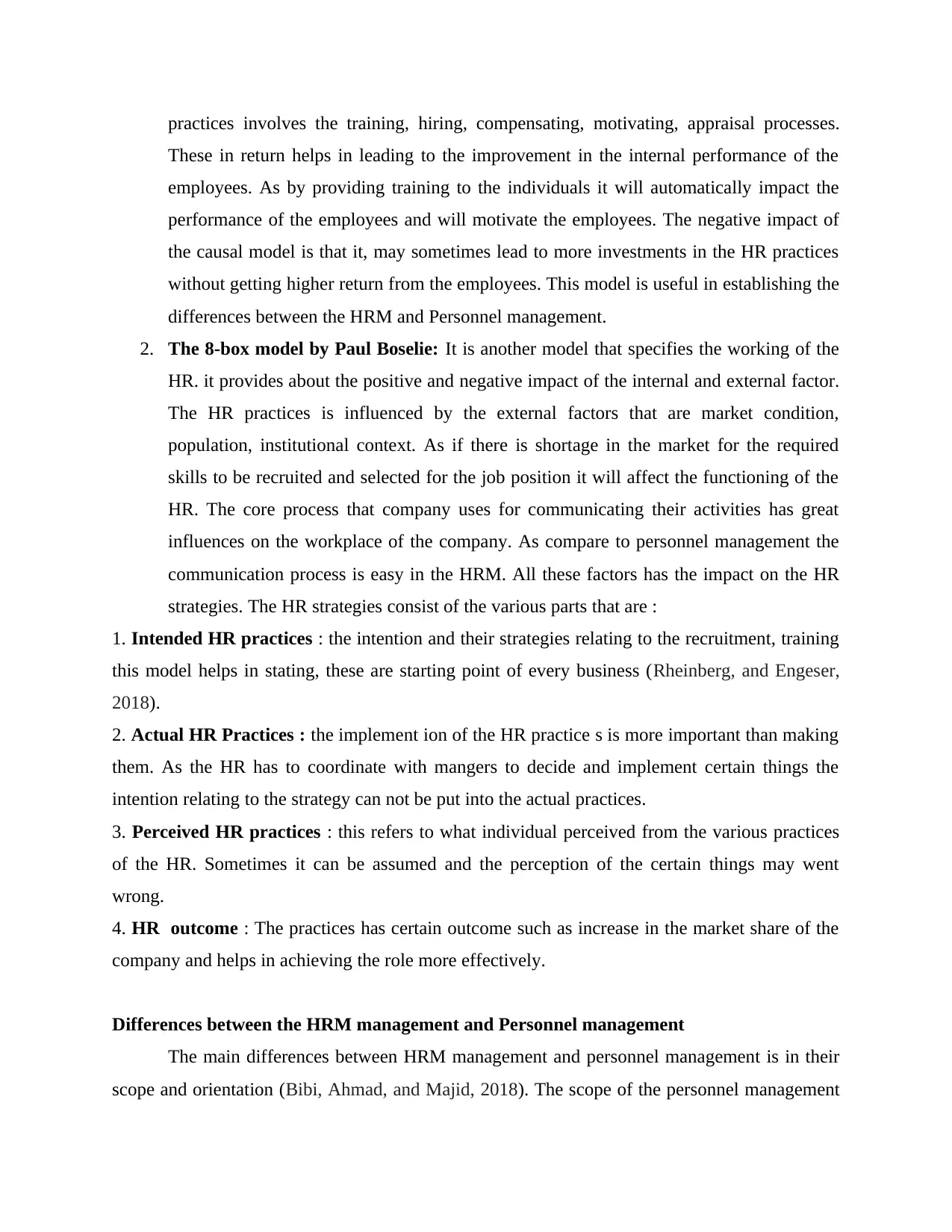
practices involves the training, hiring, compensating, motivating, appraisal processes.
These in return helps in leading to the improvement in the internal performance of the
employees. As by providing training to the individuals it will automatically impact the
performance of the employees and will motivate the employees. The negative impact of
the causal model is that it, may sometimes lead to more investments in the HR practices
without getting higher return from the employees. This model is useful in establishing the
differences between the HRM and Personnel management.
2. The 8-box model by Paul Boselie: It is another model that specifies the working of the
HR. it provides about the positive and negative impact of the internal and external factor.
The HR practices is influenced by the external factors that are market condition,
population, institutional context. As if there is shortage in the market for the required
skills to be recruited and selected for the job position it will affect the functioning of the
HR. The core process that company uses for communicating their activities has great
influences on the workplace of the company. As compare to personnel management the
communication process is easy in the HRM. All these factors has the impact on the HR
strategies. The HR strategies consist of the various parts that are :
1. Intended HR practices : the intention and their strategies relating to the recruitment, training
this model helps in stating, these are starting point of every business (Rheinberg, and Engeser,
2018).
2. Actual HR Practices : the implement ion of the HR practice s is more important than making
them. As the HR has to coordinate with mangers to decide and implement certain things the
intention relating to the strategy can not be put into the actual practices.
3. Perceived HR practices : this refers to what individual perceived from the various practices
of the HR. Sometimes it can be assumed and the perception of the certain things may went
wrong.
4. HR outcome : The practices has certain outcome such as increase in the market share of the
company and helps in achieving the role more effectively.
Differences between the HRM management and Personnel management
The main differences between HRM management and personnel management is in their
scope and orientation (Bibi, Ahmad, and Majid, 2018). The scope of the personnel management
These in return helps in leading to the improvement in the internal performance of the
employees. As by providing training to the individuals it will automatically impact the
performance of the employees and will motivate the employees. The negative impact of
the causal model is that it, may sometimes lead to more investments in the HR practices
without getting higher return from the employees. This model is useful in establishing the
differences between the HRM and Personnel management.
2. The 8-box model by Paul Boselie: It is another model that specifies the working of the
HR. it provides about the positive and negative impact of the internal and external factor.
The HR practices is influenced by the external factors that are market condition,
population, institutional context. As if there is shortage in the market for the required
skills to be recruited and selected for the job position it will affect the functioning of the
HR. The core process that company uses for communicating their activities has great
influences on the workplace of the company. As compare to personnel management the
communication process is easy in the HRM. All these factors has the impact on the HR
strategies. The HR strategies consist of the various parts that are :
1. Intended HR practices : the intention and their strategies relating to the recruitment, training
this model helps in stating, these are starting point of every business (Rheinberg, and Engeser,
2018).
2. Actual HR Practices : the implement ion of the HR practice s is more important than making
them. As the HR has to coordinate with mangers to decide and implement certain things the
intention relating to the strategy can not be put into the actual practices.
3. Perceived HR practices : this refers to what individual perceived from the various practices
of the HR. Sometimes it can be assumed and the perception of the certain things may went
wrong.
4. HR outcome : The practices has certain outcome such as increase in the market share of the
company and helps in achieving the role more effectively.
Differences between the HRM management and Personnel management
The main differences between HRM management and personnel management is in their
scope and orientation (Bibi, Ahmad, and Majid, 2018). The scope of the personnel management
Secure Best Marks with AI Grader
Need help grading? Try our AI Grader for instant feedback on your assignments.
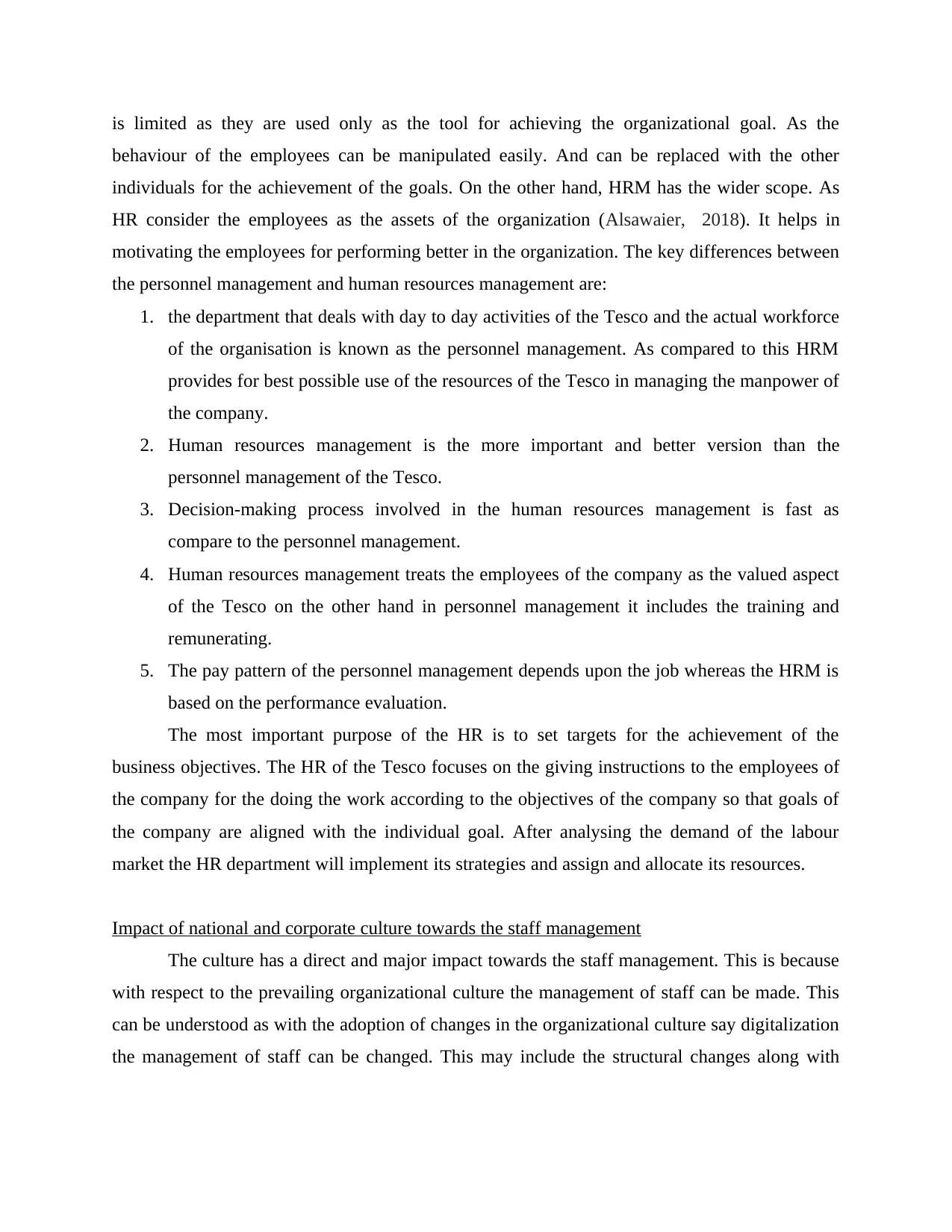
is limited as they are used only as the tool for achieving the organizational goal. As the
behaviour of the employees can be manipulated easily. And can be replaced with the other
individuals for the achievement of the goals. On the other hand, HRM has the wider scope. As
HR consider the employees as the assets of the organization (Alsawaier, 2018). It helps in
motivating the employees for performing better in the organization. The key differences between
the personnel management and human resources management are:
1. the department that deals with day to day activities of the Tesco and the actual workforce
of the organisation is known as the personnel management. As compared to this HRM
provides for best possible use of the resources of the Tesco in managing the manpower of
the company.
2. Human resources management is the more important and better version than the
personnel management of the Tesco.
3. Decision-making process involved in the human resources management is fast as
compare to the personnel management.
4. Human resources management treats the employees of the company as the valued aspect
of the Tesco on the other hand in personnel management it includes the training and
remunerating.
5. The pay pattern of the personnel management depends upon the job whereas the HRM is
based on the performance evaluation.
The most important purpose of the HR is to set targets for the achievement of the
business objectives. The HR of the Tesco focuses on the giving instructions to the employees of
the company for the doing the work according to the objectives of the company so that goals of
the company are aligned with the individual goal. After analysing the demand of the labour
market the HR department will implement its strategies and assign and allocate its resources.
Impact of national and corporate culture towards the staff management
The culture has a direct and major impact towards the staff management. This is because
with respect to the prevailing organizational culture the management of staff can be made. This
can be understood as with the adoption of changes in the organizational culture say digitalization
the management of staff can be changed. This may include the structural changes along with
behaviour of the employees can be manipulated easily. And can be replaced with the other
individuals for the achievement of the goals. On the other hand, HRM has the wider scope. As
HR consider the employees as the assets of the organization (Alsawaier, 2018). It helps in
motivating the employees for performing better in the organization. The key differences between
the personnel management and human resources management are:
1. the department that deals with day to day activities of the Tesco and the actual workforce
of the organisation is known as the personnel management. As compared to this HRM
provides for best possible use of the resources of the Tesco in managing the manpower of
the company.
2. Human resources management is the more important and better version than the
personnel management of the Tesco.
3. Decision-making process involved in the human resources management is fast as
compare to the personnel management.
4. Human resources management treats the employees of the company as the valued aspect
of the Tesco on the other hand in personnel management it includes the training and
remunerating.
5. The pay pattern of the personnel management depends upon the job whereas the HRM is
based on the performance evaluation.
The most important purpose of the HR is to set targets for the achievement of the
business objectives. The HR of the Tesco focuses on the giving instructions to the employees of
the company for the doing the work according to the objectives of the company so that goals of
the company are aligned with the individual goal. After analysing the demand of the labour
market the HR department will implement its strategies and assign and allocate its resources.
Impact of national and corporate culture towards the staff management
The culture has a direct and major impact towards the staff management. This is because
with respect to the prevailing organizational culture the management of staff can be made. This
can be understood as with the adoption of changes in the organizational culture say digitalization
the management of staff can be changed. This may include the structural changes along with
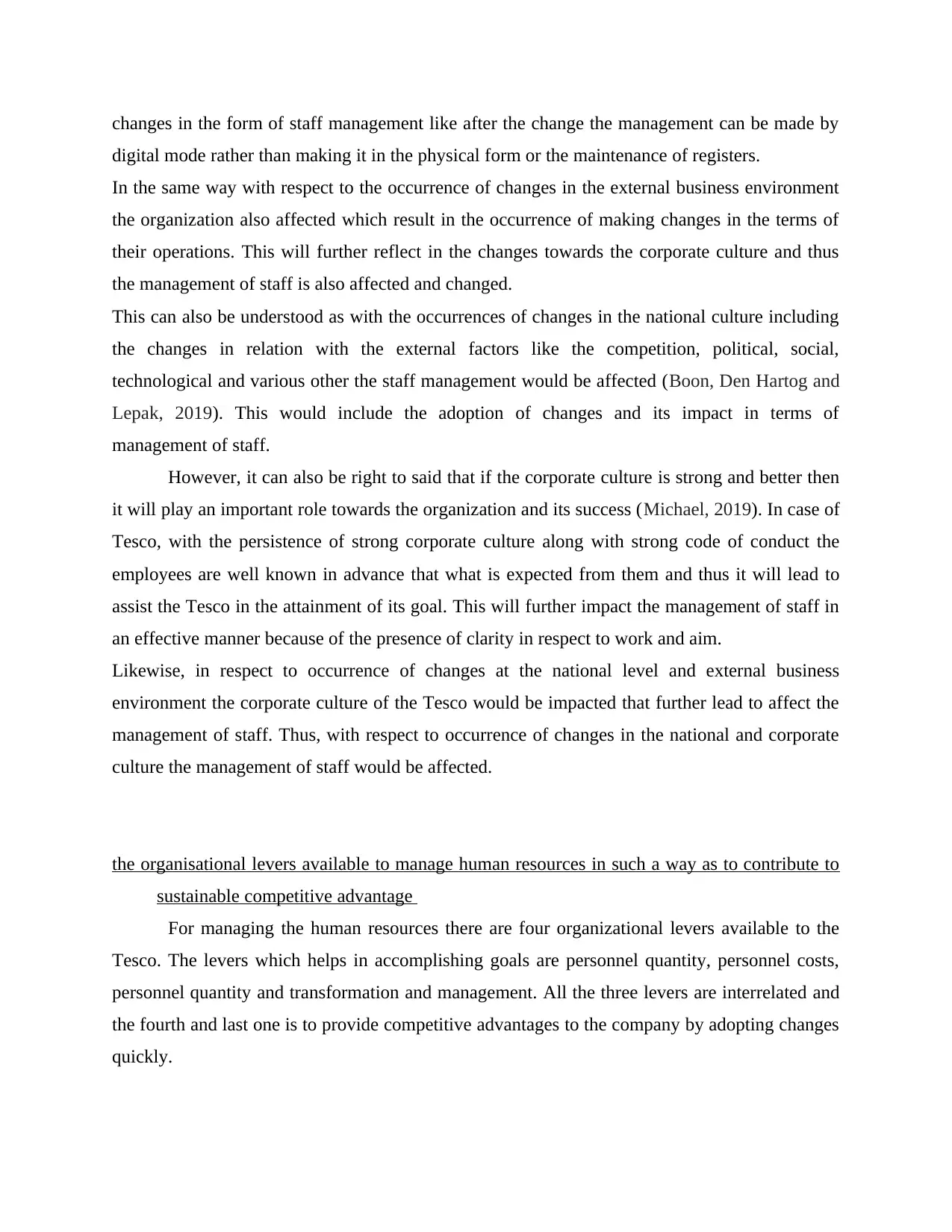
changes in the form of staff management like after the change the management can be made by
digital mode rather than making it in the physical form or the maintenance of registers.
In the same way with respect to the occurrence of changes in the external business environment
the organization also affected which result in the occurrence of making changes in the terms of
their operations. This will further reflect in the changes towards the corporate culture and thus
the management of staff is also affected and changed.
This can also be understood as with the occurrences of changes in the national culture including
the changes in relation with the external factors like the competition, political, social,
technological and various other the staff management would be affected (Boon, Den Hartog and
Lepak, 2019). This would include the adoption of changes and its impact in terms of
management of staff.
However, it can also be right to said that if the corporate culture is strong and better then
it will play an important role towards the organization and its success (Michael, 2019). In case of
Tesco, with the persistence of strong corporate culture along with strong code of conduct the
employees are well known in advance that what is expected from them and thus it will lead to
assist the Tesco in the attainment of its goal. This will further impact the management of staff in
an effective manner because of the presence of clarity in respect to work and aim.
Likewise, in respect to occurrence of changes at the national level and external business
environment the corporate culture of the Tesco would be impacted that further lead to affect the
management of staff. Thus, with respect to occurrence of changes in the national and corporate
culture the management of staff would be affected.
the organisational levers available to manage human resources in such a way as to contribute to
sustainable competitive advantage
For managing the human resources there are four organizational levers available to the
Tesco. The levers which helps in accomplishing goals are personnel quantity, personnel costs,
personnel quantity and transformation and management. All the three levers are interrelated and
the fourth and last one is to provide competitive advantages to the company by adopting changes
quickly.
digital mode rather than making it in the physical form or the maintenance of registers.
In the same way with respect to the occurrence of changes in the external business environment
the organization also affected which result in the occurrence of making changes in the terms of
their operations. This will further reflect in the changes towards the corporate culture and thus
the management of staff is also affected and changed.
This can also be understood as with the occurrences of changes in the national culture including
the changes in relation with the external factors like the competition, political, social,
technological and various other the staff management would be affected (Boon, Den Hartog and
Lepak, 2019). This would include the adoption of changes and its impact in terms of
management of staff.
However, it can also be right to said that if the corporate culture is strong and better then
it will play an important role towards the organization and its success (Michael, 2019). In case of
Tesco, with the persistence of strong corporate culture along with strong code of conduct the
employees are well known in advance that what is expected from them and thus it will lead to
assist the Tesco in the attainment of its goal. This will further impact the management of staff in
an effective manner because of the presence of clarity in respect to work and aim.
Likewise, in respect to occurrence of changes at the national level and external business
environment the corporate culture of the Tesco would be impacted that further lead to affect the
management of staff. Thus, with respect to occurrence of changes in the national and corporate
culture the management of staff would be affected.
the organisational levers available to manage human resources in such a way as to contribute to
sustainable competitive advantage
For managing the human resources there are four organizational levers available to the
Tesco. The levers which helps in accomplishing goals are personnel quantity, personnel costs,
personnel quantity and transformation and management. All the three levers are interrelated and
the fourth and last one is to provide competitive advantages to the company by adopting changes
quickly.
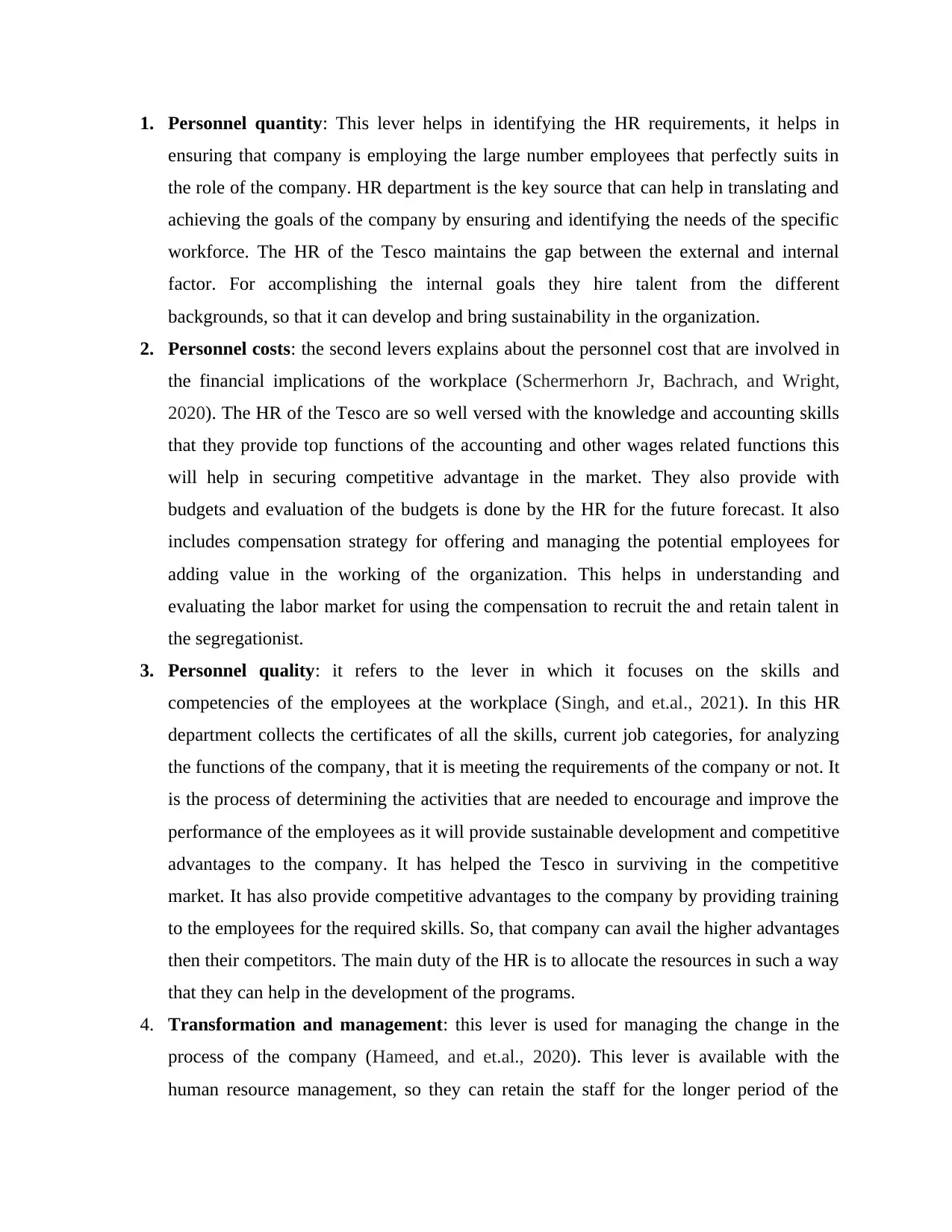
1. Personnel quantity: This lever helps in identifying the HR requirements, it helps in
ensuring that company is employing the large number employees that perfectly suits in
the role of the company. HR department is the key source that can help in translating and
achieving the goals of the company by ensuring and identifying the needs of the specific
workforce. The HR of the Tesco maintains the gap between the external and internal
factor. For accomplishing the internal goals they hire talent from the different
backgrounds, so that it can develop and bring sustainability in the organization.
2. Personnel costs: the second levers explains about the personnel cost that are involved in
the financial implications of the workplace (Schermerhorn Jr, Bachrach, and Wright,
2020). The HR of the Tesco are so well versed with the knowledge and accounting skills
that they provide top functions of the accounting and other wages related functions this
will help in securing competitive advantage in the market. They also provide with
budgets and evaluation of the budgets is done by the HR for the future forecast. It also
includes compensation strategy for offering and managing the potential employees for
adding value in the working of the organization. This helps in understanding and
evaluating the labor market for using the compensation to recruit the and retain talent in
the segregationist.
3. Personnel quality: it refers to the lever in which it focuses on the skills and
competencies of the employees at the workplace (Singh, and et.al., 2021). In this HR
department collects the certificates of all the skills, current job categories, for analyzing
the functions of the company, that it is meeting the requirements of the company or not. It
is the process of determining the activities that are needed to encourage and improve the
performance of the employees as it will provide sustainable development and competitive
advantages to the company. It has helped the Tesco in surviving in the competitive
market. It has also provide competitive advantages to the company by providing training
to the employees for the required skills. So, that company can avail the higher advantages
then their competitors. The main duty of the HR is to allocate the resources in such a way
that they can help in the development of the programs.
4. Transformation and management: this lever is used for managing the change in the
process of the company (Hameed, and et.al., 2020). This lever is available with the
human resource management, so they can retain the staff for the longer period of the
ensuring that company is employing the large number employees that perfectly suits in
the role of the company. HR department is the key source that can help in translating and
achieving the goals of the company by ensuring and identifying the needs of the specific
workforce. The HR of the Tesco maintains the gap between the external and internal
factor. For accomplishing the internal goals they hire talent from the different
backgrounds, so that it can develop and bring sustainability in the organization.
2. Personnel costs: the second levers explains about the personnel cost that are involved in
the financial implications of the workplace (Schermerhorn Jr, Bachrach, and Wright,
2020). The HR of the Tesco are so well versed with the knowledge and accounting skills
that they provide top functions of the accounting and other wages related functions this
will help in securing competitive advantage in the market. They also provide with
budgets and evaluation of the budgets is done by the HR for the future forecast. It also
includes compensation strategy for offering and managing the potential employees for
adding value in the working of the organization. This helps in understanding and
evaluating the labor market for using the compensation to recruit the and retain talent in
the segregationist.
3. Personnel quality: it refers to the lever in which it focuses on the skills and
competencies of the employees at the workplace (Singh, and et.al., 2021). In this HR
department collects the certificates of all the skills, current job categories, for analyzing
the functions of the company, that it is meeting the requirements of the company or not. It
is the process of determining the activities that are needed to encourage and improve the
performance of the employees as it will provide sustainable development and competitive
advantages to the company. It has helped the Tesco in surviving in the competitive
market. It has also provide competitive advantages to the company by providing training
to the employees for the required skills. So, that company can avail the higher advantages
then their competitors. The main duty of the HR is to allocate the resources in such a way
that they can help in the development of the programs.
4. Transformation and management: this lever is used for managing the change in the
process of the company (Hameed, and et.al., 2020). This lever is available with the
human resource management, so they can retain the staff for the longer period of the
Paraphrase This Document
Need a fresh take? Get an instant paraphrase of this document with our AI Paraphraser
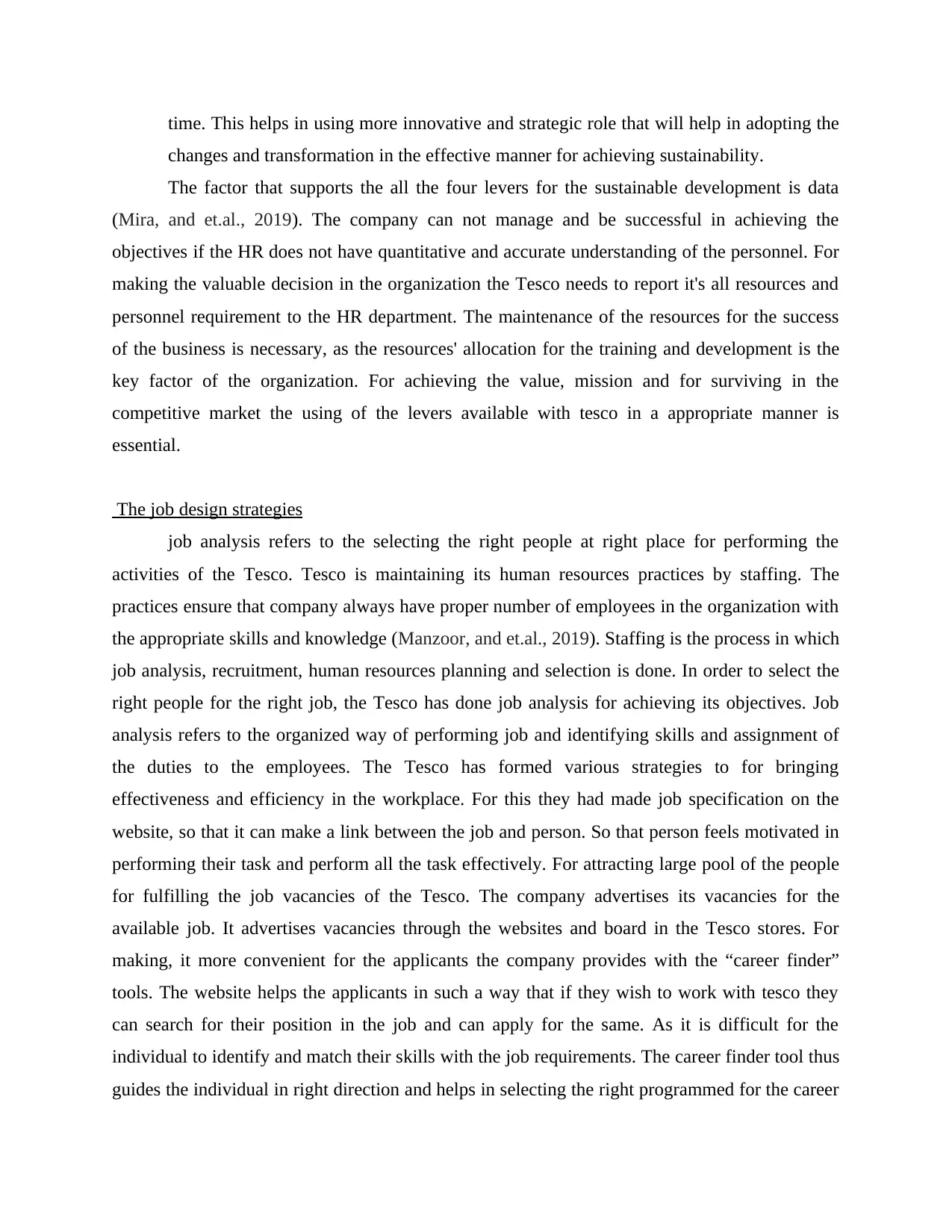
time. This helps in using more innovative and strategic role that will help in adopting the
changes and transformation in the effective manner for achieving sustainability.
The factor that supports the all the four levers for the sustainable development is data
(Mira, and et.al., 2019). The company can not manage and be successful in achieving the
objectives if the HR does not have quantitative and accurate understanding of the personnel. For
making the valuable decision in the organization the Tesco needs to report it's all resources and
personnel requirement to the HR department. The maintenance of the resources for the success
of the business is necessary, as the resources' allocation for the training and development is the
key factor of the organization. For achieving the value, mission and for surviving in the
competitive market the using of the levers available with tesco in a appropriate manner is
essential.
The job design strategies
job analysis refers to the selecting the right people at right place for performing the
activities of the Tesco. Tesco is maintaining its human resources practices by staffing. The
practices ensure that company always have proper number of employees in the organization with
the appropriate skills and knowledge (Manzoor, and et.al., 2019). Staffing is the process in which
job analysis, recruitment, human resources planning and selection is done. In order to select the
right people for the right job, the Tesco has done job analysis for achieving its objectives. Job
analysis refers to the organized way of performing job and identifying skills and assignment of
the duties to the employees. The Tesco has formed various strategies to for bringing
effectiveness and efficiency in the workplace. For this they had made job specification on the
website, so that it can make a link between the job and person. So that person feels motivated in
performing their task and perform all the task effectively. For attracting large pool of the people
for fulfilling the job vacancies of the Tesco. The company advertises its vacancies for the
available job. It advertises vacancies through the websites and board in the Tesco stores. For
making, it more convenient for the applicants the company provides with the “career finder”
tools. The website helps the applicants in such a way that if they wish to work with tesco they
can search for their position in the job and can apply for the same. As it is difficult for the
individual to identify and match their skills with the job requirements. The career finder tool thus
guides the individual in right direction and helps in selecting the right programmed for the career
changes and transformation in the effective manner for achieving sustainability.
The factor that supports the all the four levers for the sustainable development is data
(Mira, and et.al., 2019). The company can not manage and be successful in achieving the
objectives if the HR does not have quantitative and accurate understanding of the personnel. For
making the valuable decision in the organization the Tesco needs to report it's all resources and
personnel requirement to the HR department. The maintenance of the resources for the success
of the business is necessary, as the resources' allocation for the training and development is the
key factor of the organization. For achieving the value, mission and for surviving in the
competitive market the using of the levers available with tesco in a appropriate manner is
essential.
The job design strategies
job analysis refers to the selecting the right people at right place for performing the
activities of the Tesco. Tesco is maintaining its human resources practices by staffing. The
practices ensure that company always have proper number of employees in the organization with
the appropriate skills and knowledge (Manzoor, and et.al., 2019). Staffing is the process in which
job analysis, recruitment, human resources planning and selection is done. In order to select the
right people for the right job, the Tesco has done job analysis for achieving its objectives. Job
analysis refers to the organized way of performing job and identifying skills and assignment of
the duties to the employees. The Tesco has formed various strategies to for bringing
effectiveness and efficiency in the workplace. For this they had made job specification on the
website, so that it can make a link between the job and person. So that person feels motivated in
performing their task and perform all the task effectively. For attracting large pool of the people
for fulfilling the job vacancies of the Tesco. The company advertises its vacancies for the
available job. It advertises vacancies through the websites and board in the Tesco stores. For
making, it more convenient for the applicants the company provides with the “career finder”
tools. The website helps the applicants in such a way that if they wish to work with tesco they
can search for their position in the job and can apply for the same. As it is difficult for the
individual to identify and match their skills with the job requirements. The career finder tool thus
guides the individual in right direction and helps in selecting the right programmed for the career
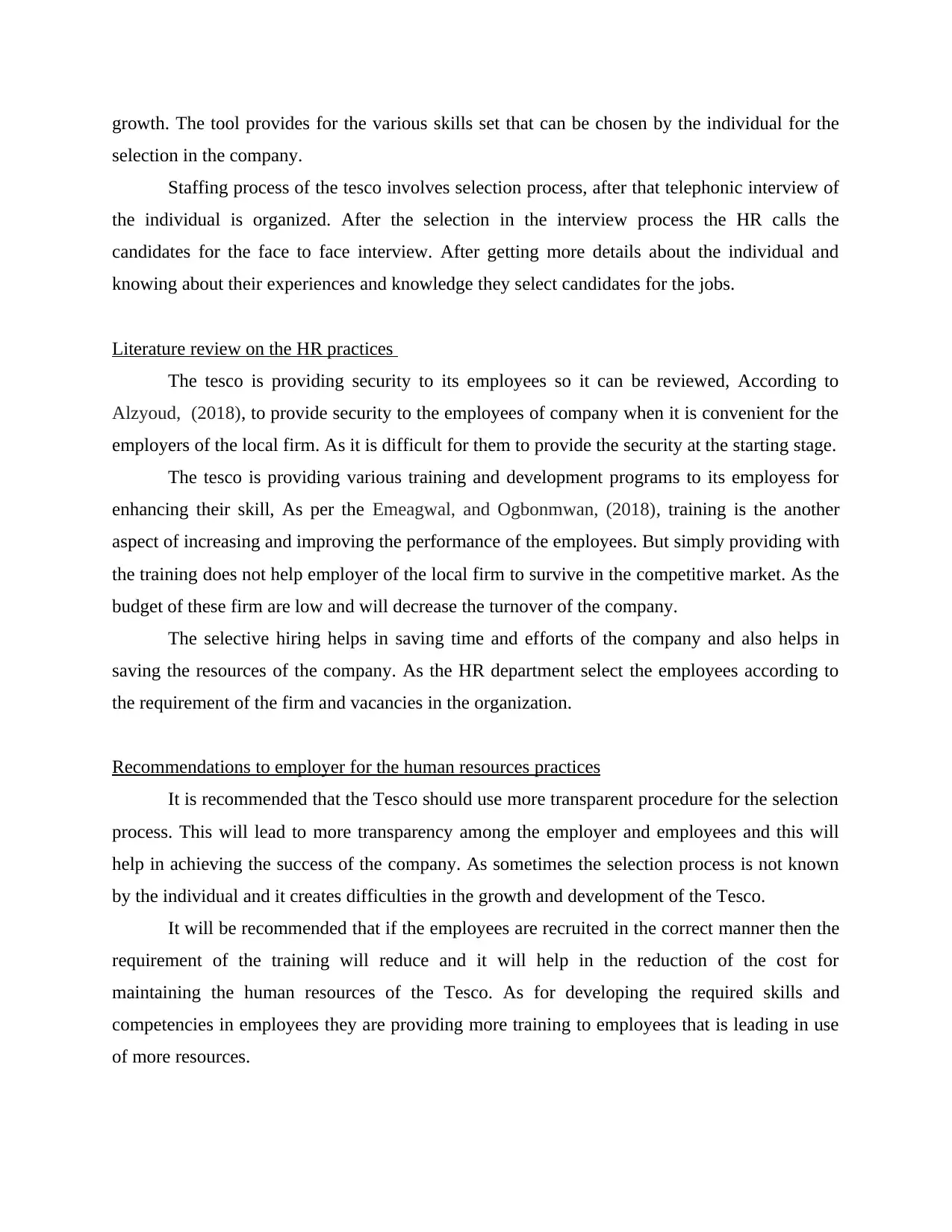
growth. The tool provides for the various skills set that can be chosen by the individual for the
selection in the company.
Staffing process of the tesco involves selection process, after that telephonic interview of
the individual is organized. After the selection in the interview process the HR calls the
candidates for the face to face interview. After getting more details about the individual and
knowing about their experiences and knowledge they select candidates for the jobs.
Literature review on the HR practices
The tesco is providing security to its employees so it can be reviewed, According to
Alzyoud, (2018), to provide security to the employees of company when it is convenient for the
employers of the local firm. As it is difficult for them to provide the security at the starting stage.
The tesco is providing various training and development programs to its employess for
enhancing their skill, As per the Emeagwal, and Ogbonmwan, (2018), training is the another
aspect of increasing and improving the performance of the employees. But simply providing with
the training does not help employer of the local firm to survive in the competitive market. As the
budget of these firm are low and will decrease the turnover of the company.
The selective hiring helps in saving time and efforts of the company and also helps in
saving the resources of the company. As the HR department select the employees according to
the requirement of the firm and vacancies in the organization.
Recommendations to employer for the human resources practices
It is recommended that the Tesco should use more transparent procedure for the selection
process. This will lead to more transparency among the employer and employees and this will
help in achieving the success of the company. As sometimes the selection process is not known
by the individual and it creates difficulties in the growth and development of the Tesco.
It will be recommended that if the employees are recruited in the correct manner then the
requirement of the training will reduce and it will help in the reduction of the cost for
maintaining the human resources of the Tesco. As for developing the required skills and
competencies in employees they are providing more training to employees that is leading in use
of more resources.
selection in the company.
Staffing process of the tesco involves selection process, after that telephonic interview of
the individual is organized. After the selection in the interview process the HR calls the
candidates for the face to face interview. After getting more details about the individual and
knowing about their experiences and knowledge they select candidates for the jobs.
Literature review on the HR practices
The tesco is providing security to its employees so it can be reviewed, According to
Alzyoud, (2018), to provide security to the employees of company when it is convenient for the
employers of the local firm. As it is difficult for them to provide the security at the starting stage.
The tesco is providing various training and development programs to its employess for
enhancing their skill, As per the Emeagwal, and Ogbonmwan, (2018), training is the another
aspect of increasing and improving the performance of the employees. But simply providing with
the training does not help employer of the local firm to survive in the competitive market. As the
budget of these firm are low and will decrease the turnover of the company.
The selective hiring helps in saving time and efforts of the company and also helps in
saving the resources of the company. As the HR department select the employees according to
the requirement of the firm and vacancies in the organization.
Recommendations to employer for the human resources practices
It is recommended that the Tesco should use more transparent procedure for the selection
process. This will lead to more transparency among the employer and employees and this will
help in achieving the success of the company. As sometimes the selection process is not known
by the individual and it creates difficulties in the growth and development of the Tesco.
It will be recommended that if the employees are recruited in the correct manner then the
requirement of the training will reduce and it will help in the reduction of the cost for
maintaining the human resources of the Tesco. As for developing the required skills and
competencies in employees they are providing more training to employees that is leading in use
of more resources.
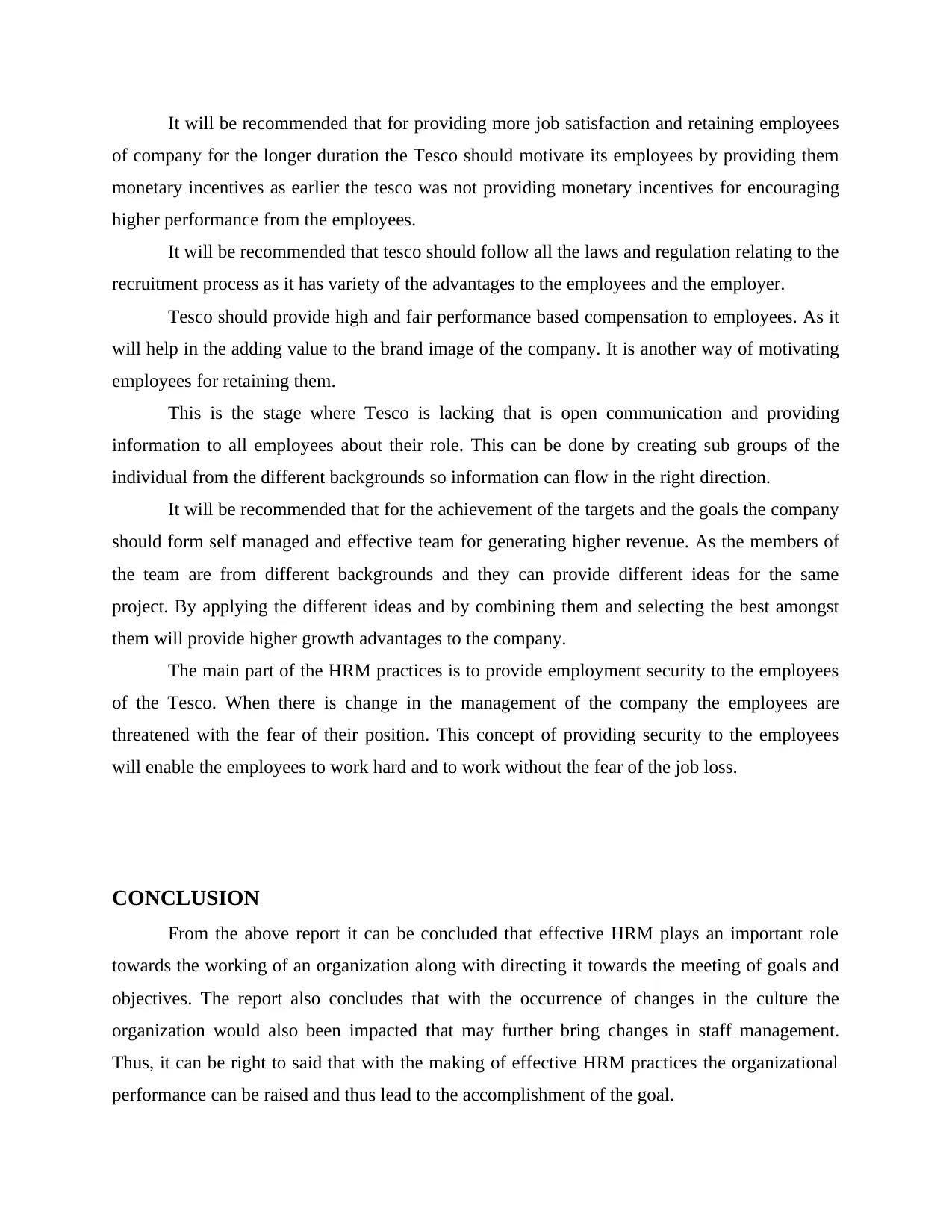
It will be recommended that for providing more job satisfaction and retaining employees
of company for the longer duration the Tesco should motivate its employees by providing them
monetary incentives as earlier the tesco was not providing monetary incentives for encouraging
higher performance from the employees.
It will be recommended that tesco should follow all the laws and regulation relating to the
recruitment process as it has variety of the advantages to the employees and the employer.
Tesco should provide high and fair performance based compensation to employees. As it
will help in the adding value to the brand image of the company. It is another way of motivating
employees for retaining them.
This is the stage where Tesco is lacking that is open communication and providing
information to all employees about their role. This can be done by creating sub groups of the
individual from the different backgrounds so information can flow in the right direction.
It will be recommended that for the achievement of the targets and the goals the company
should form self managed and effective team for generating higher revenue. As the members of
the team are from different backgrounds and they can provide different ideas for the same
project. By applying the different ideas and by combining them and selecting the best amongst
them will provide higher growth advantages to the company.
The main part of the HRM practices is to provide employment security to the employees
of the Tesco. When there is change in the management of the company the employees are
threatened with the fear of their position. This concept of providing security to the employees
will enable the employees to work hard and to work without the fear of the job loss.
CONCLUSION
From the above report it can be concluded that effective HRM plays an important role
towards the working of an organization along with directing it towards the meeting of goals and
objectives. The report also concludes that with the occurrence of changes in the culture the
organization would also been impacted that may further bring changes in staff management.
Thus, it can be right to said that with the making of effective HRM practices the organizational
performance can be raised and thus lead to the accomplishment of the goal.
of company for the longer duration the Tesco should motivate its employees by providing them
monetary incentives as earlier the tesco was not providing monetary incentives for encouraging
higher performance from the employees.
It will be recommended that tesco should follow all the laws and regulation relating to the
recruitment process as it has variety of the advantages to the employees and the employer.
Tesco should provide high and fair performance based compensation to employees. As it
will help in the adding value to the brand image of the company. It is another way of motivating
employees for retaining them.
This is the stage where Tesco is lacking that is open communication and providing
information to all employees about their role. This can be done by creating sub groups of the
individual from the different backgrounds so information can flow in the right direction.
It will be recommended that for the achievement of the targets and the goals the company
should form self managed and effective team for generating higher revenue. As the members of
the team are from different backgrounds and they can provide different ideas for the same
project. By applying the different ideas and by combining them and selecting the best amongst
them will provide higher growth advantages to the company.
The main part of the HRM practices is to provide employment security to the employees
of the Tesco. When there is change in the management of the company the employees are
threatened with the fear of their position. This concept of providing security to the employees
will enable the employees to work hard and to work without the fear of the job loss.
CONCLUSION
From the above report it can be concluded that effective HRM plays an important role
towards the working of an organization along with directing it towards the meeting of goals and
objectives. The report also concludes that with the occurrence of changes in the culture the
organization would also been impacted that may further bring changes in staff management.
Thus, it can be right to said that with the making of effective HRM practices the organizational
performance can be raised and thus lead to the accomplishment of the goal.
Secure Best Marks with AI Grader
Need help grading? Try our AI Grader for instant feedback on your assignments.

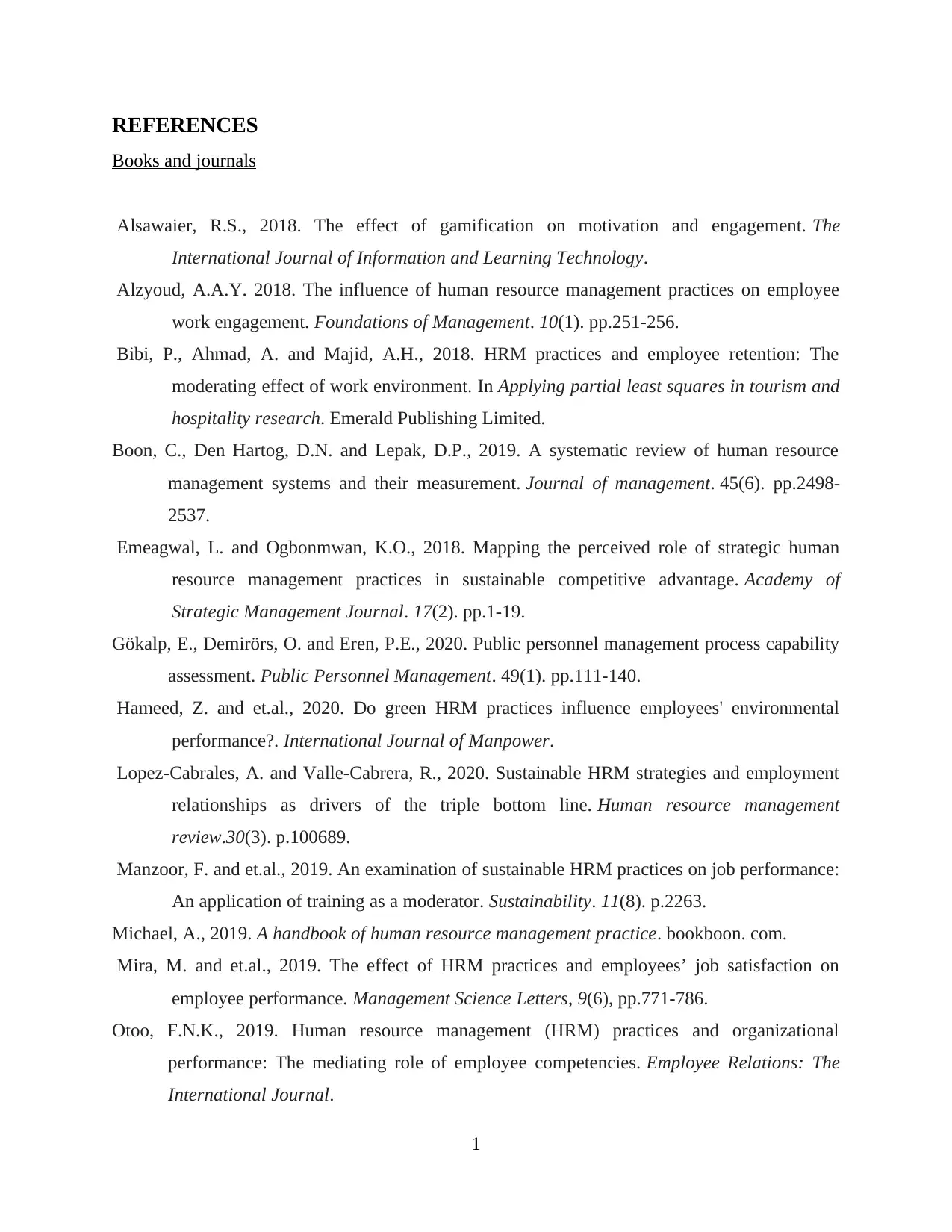
REFERENCES
Books and journals
Alsawaier, R.S., 2018. The effect of gamification on motivation and engagement. The
International Journal of Information and Learning Technology.
Alzyoud, A.A.Y. 2018. The influence of human resource management practices on employee
work engagement. Foundations of Management. 10(1). pp.251-256.
Bibi, P., Ahmad, A. and Majid, A.H., 2018. HRM practices and employee retention: The
moderating effect of work environment. In Applying partial least squares in tourism and
hospitality research. Emerald Publishing Limited.
Boon, C., Den Hartog, D.N. and Lepak, D.P., 2019. A systematic review of human resource
management systems and their measurement. Journal of management. 45(6). pp.2498-
2537.
Emeagwal, L. and Ogbonmwan, K.O., 2018. Mapping the perceived role of strategic human
resource management practices in sustainable competitive advantage. Academy of
Strategic Management Journal. 17(2). pp.1-19.
Gökalp, E., Demirörs, O. and Eren, P.E., 2020. Public personnel management process capability
assessment. Public Personnel Management. 49(1). pp.111-140.
Hameed, Z. and et.al., 2020. Do green HRM practices influence employees' environmental
performance?. International Journal of Manpower.
Lopez-Cabrales, A. and Valle-Cabrera, R., 2020. Sustainable HRM strategies and employment
relationships as drivers of the triple bottom line. Human resource management
review.30(3). p.100689.
Manzoor, F. and et.al., 2019. An examination of sustainable HRM practices on job performance:
An application of training as a moderator. Sustainability. 11(8). p.2263.
Michael, A., 2019. A handbook of human resource management practice. bookboon. com.
Mira, M. and et.al., 2019. The effect of HRM practices and employees’ job satisfaction on
employee performance. Management Science Letters, 9(6), pp.771-786.
Otoo, F.N.K., 2019. Human resource management (HRM) practices and organizational
performance: The mediating role of employee competencies. Employee Relations: The
International Journal.
1
Books and journals
Alsawaier, R.S., 2018. The effect of gamification on motivation and engagement. The
International Journal of Information and Learning Technology.
Alzyoud, A.A.Y. 2018. The influence of human resource management practices on employee
work engagement. Foundations of Management. 10(1). pp.251-256.
Bibi, P., Ahmad, A. and Majid, A.H., 2018. HRM practices and employee retention: The
moderating effect of work environment. In Applying partial least squares in tourism and
hospitality research. Emerald Publishing Limited.
Boon, C., Den Hartog, D.N. and Lepak, D.P., 2019. A systematic review of human resource
management systems and their measurement. Journal of management. 45(6). pp.2498-
2537.
Emeagwal, L. and Ogbonmwan, K.O., 2018. Mapping the perceived role of strategic human
resource management practices in sustainable competitive advantage. Academy of
Strategic Management Journal. 17(2). pp.1-19.
Gökalp, E., Demirörs, O. and Eren, P.E., 2020. Public personnel management process capability
assessment. Public Personnel Management. 49(1). pp.111-140.
Hameed, Z. and et.al., 2020. Do green HRM practices influence employees' environmental
performance?. International Journal of Manpower.
Lopez-Cabrales, A. and Valle-Cabrera, R., 2020. Sustainable HRM strategies and employment
relationships as drivers of the triple bottom line. Human resource management
review.30(3). p.100689.
Manzoor, F. and et.al., 2019. An examination of sustainable HRM practices on job performance:
An application of training as a moderator. Sustainability. 11(8). p.2263.
Michael, A., 2019. A handbook of human resource management practice. bookboon. com.
Mira, M. and et.al., 2019. The effect of HRM practices and employees’ job satisfaction on
employee performance. Management Science Letters, 9(6), pp.771-786.
Otoo, F.N.K., 2019. Human resource management (HRM) practices and organizational
performance: The mediating role of employee competencies. Employee Relations: The
International Journal.
1
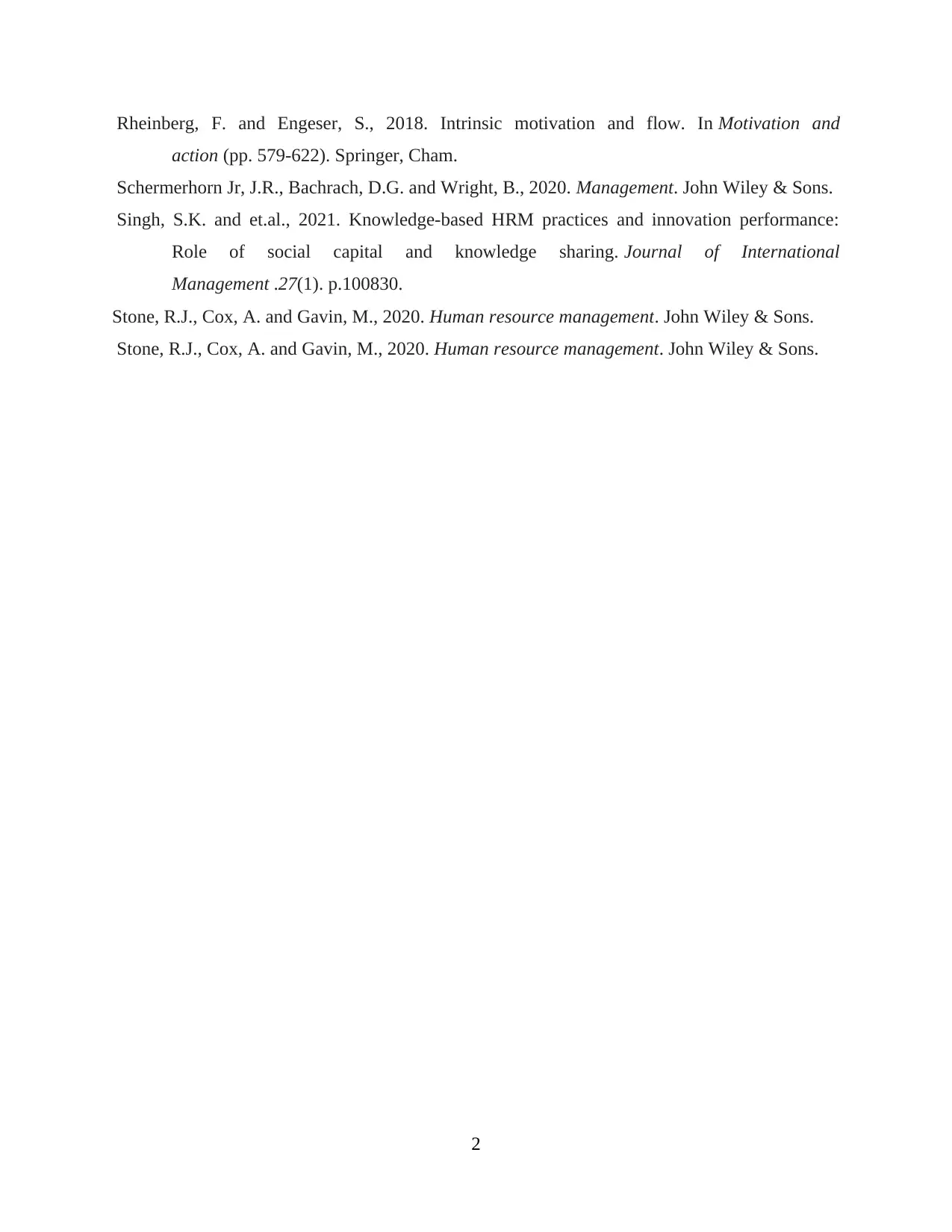
Rheinberg, F. and Engeser, S., 2018. Intrinsic motivation and flow. In Motivation and
action (pp. 579-622). Springer, Cham.
Schermerhorn Jr, J.R., Bachrach, D.G. and Wright, B., 2020. Management. John Wiley & Sons.
Singh, S.K. and et.al., 2021. Knowledge-based HRM practices and innovation performance:
Role of social capital and knowledge sharing. Journal of International
Management .27(1). p.100830.
Stone, R.J., Cox, A. and Gavin, M., 2020. Human resource management. John Wiley & Sons.
Stone, R.J., Cox, A. and Gavin, M., 2020. Human resource management. John Wiley & Sons.
2
action (pp. 579-622). Springer, Cham.
Schermerhorn Jr, J.R., Bachrach, D.G. and Wright, B., 2020. Management. John Wiley & Sons.
Singh, S.K. and et.al., 2021. Knowledge-based HRM practices and innovation performance:
Role of social capital and knowledge sharing. Journal of International
Management .27(1). p.100830.
Stone, R.J., Cox, A. and Gavin, M., 2020. Human resource management. John Wiley & Sons.
Stone, R.J., Cox, A. and Gavin, M., 2020. Human resource management. John Wiley & Sons.
2
1 out of 13
Related Documents
Your All-in-One AI-Powered Toolkit for Academic Success.
+13062052269
info@desklib.com
Available 24*7 on WhatsApp / Email
![[object Object]](/_next/static/media/star-bottom.7253800d.svg)
Unlock your academic potential
© 2024 | Zucol Services PVT LTD | All rights reserved.


